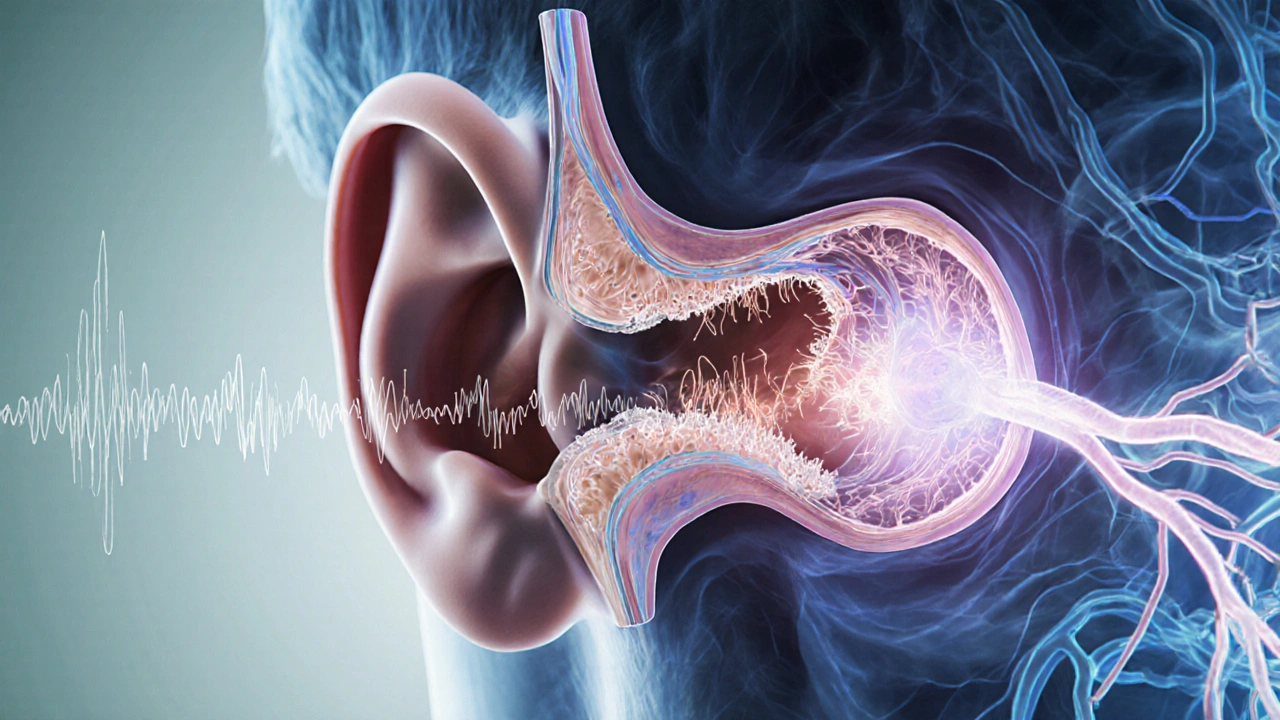Hearing Loss & Tinnitus Connection Quiz
This interactive quiz helps you understand how hearing loss and tinnitus are connected. Answer the questions below to learn more about shared causes and symptoms.
Quiz Results
Tinnitus Overview
Tinnitus is the perception of sound without an external source. It affects about 15% of the global population.
Hearing Loss Types
Sensorineural hearing loss is the most common type in adults and is often linked to aging, noise, or ototoxic substances.
When it comes to Hearing Loss is a condition where the ear or nerve pathways can’t detect sounds as well as they used to. Many people also notice tinnitus-the persistent ringing, buzzing, or hissing in the ears. The two often appear together, which makes you wonder: is one causing the other? This article untangles the science, the common culprits, and what you can actually do about it.
Key Takeaways
- Damage to the cochlea or auditory nerve can trigger both hearing loss and tinnitus.
- Noise exposure, certain medications, and age‑related changes are the top three shared causes.
- Professional assessment (audiogram + tinnitus pitch match) is essential for accurate diagnosis.
- Treatments range from hearing aids and sound therapy to medication adjustments and lifestyle tweaks.
- Prevention starts with protecting your ears and managing health conditions early.
What Is Hearing Loss?
Hearing loss is a reduction in the ability to hear sounds across one or more frequencies. It can be classified by where it occurs:
- Conductive: problem in the outer or middle ear (e.g., earwax, otosclerosis).
- Sensorineural: damage to the inner ear (cochlea) or auditory nerve.
- Mixed: combination of both.
The most common type in adults is sensorineural, often linked to aging, noise, or ototoxic substances.
What Is Tinnitus (Ear Ringing)?
Tinnitus is the perception of sound when no external source exists. It’s not a disease itself but a symptom of an underlying issue. Sounds can range from high‑pitched ringing to low‑frequency humming, and they may be constant or intermittent.
About 15% of the global population experiences tinnitus at some point, and roughly half of those also have some degree of hearing loss.

How Damage Connects the Two
The cochlea contains hair cells that convert sound vibrations into electrical signals. When these cells are damaged-by loud noise, chemicals, or aging-they send erratic signals to the brain. The brain, trying to make sense of the faulty input, often creates phantom sounds, which we call tinnitus.
Similarly, damage to the auditory nerve disrupts the transmission of sound information, worsening both hearing clarity and the likelihood of phantom noise.
Shared Causes: Why They Often Appear Together
Below are the most frequent culprits that can produce both hearing loss and tinnitus.
- Noise Exposure: Prolonged exposure to loud music, machinery, or firearms damages hair cells.
- Ototoxic Drugs: Medications such as aminoglycoside antibiotics, chemotherapy agents, and high‑dose aspirin can harm the inner ear.
- Age‑Related Changes: Presbycusis slowly reduces hearing sensitivity and can trigger tinnitus.
- Meniere’s Disease: Fluid imbalance in the inner ear causes fluctuating hearing loss and roaring tinnitus.
- Vestibular Schwannoma (acoustic neuroma): A benign tumor pressing on the auditory nerve leads to progressive loss and high‑pitched ringing.
Quick Comparison of Major Causes
| Cause | Typical Effect on Hearing | Typical Tinnitus Pattern | Reversibility |
|---|---|---|---|
| Noise Exposure | High‑frequency loss | Ringing, often high‑pitched | Partial (if caught early) |
| Ototoxic Drugs | Broad‑range loss | Buzzing or hissing | Often reversible after cessation |
| Age‑Related | Gradual loss across frequencies | Low‑to‑mid frequency hum | Irreversible |
| Meniere’s Disease | Fluctuating low‑frequency loss | Roaring or booming sounds | Variable, managed with diet/meds |
| Vestibular Schwannoma | Unilateral progressive loss | High‑pitched, one‑sided | Requires surgery/radiation |
How Professionals Diagnose the Link
Doctors start with a standard audiogram to map hearing thresholds across frequencies. If the audiogram shows a dip and the patient reports ringing, a tinnitus evaluation follows:
- Pitch Matching: The clinician plays tones to match the perceived tinnitus frequency.
- Loudness Matching: Determines how loud the phantom sound feels.
- Questionnaires: Tools like the Tinnitus Handicap Inventory gauge impact on daily life.
Imaging (MRI or CT) may be ordered if a tumor or structural issue is suspected.

Treatment Options That Target Both Issues
Because the root causes often overlap, many interventions help both hearing loss and tinnitus.
- Hearing Aids: Amplify external sounds, reducing the brain’s need to generate phantom noise.
- Sound Therapy: Uses background noise (white noise, nature sounds) to mask tinnitus and improve hearing comfort.
- Cognitive‑Behavioral Therapy (CBT): Teaches coping strategies, lessening the distress tinnitus causes.
- Medication Review: Switching or stopping ototoxic drugs can halt progression.
- Diet & Lifestyle: Low‑salt diets for Meniere’s, regular exercise to improve circulation.
- Surgical Options: For tumors or severe Meniere’s, procedures can preserve or restore hearing.
Each plan should be personalized. An audiologist and ENT specialist often work together to find the right mix.
Preventing Future Problems
Prevention is the simplest, most cost‑effective strategy.
- Protect Your Ears: Use earplugs or noise‑cancelling headphones in loud environments.
- Monitor Medication: Ask your doctor about ototoxic risk before starting new drugs.
- Regular Check‑ups: Early audiograms catch subtle changes before they become permanent.
- Manage Health Conditions: Control blood pressure, diabetes, and cholesterol, which affect inner‑ear blood flow.
- Healthy Lifestyle: Adequate sleep and stress reduction reduce tinnitus perception.
Living With Both Conditions
Many people wonder if life can return to “normal.” While some degree of adjustment is inevitable, most individuals find relief with the right combination of devices, therapy, and habits. Support groups-online or local-provide shared experiences and practical tips.
Frequently Asked Questions
Can I develop tinnitus without any hearing loss?
Yes. Some people experience tinnitus while their audiogram looks normal. This often happens after brief loud exposure, stress, or medication side‑effects. However, even subtle inner‑ear changes that aren’t captured by standard tests can be the hidden cause.
Is tinnitus always permanent?
Not always. If the underlying trigger-like a loud event or ototoxic drug-is removed quickly, the ringing may fade within weeks. Chronic tinnitus usually requires management rather than a cure.
Do hearing aids actually reduce the ringing?
For many, yes. By amplifying external sounds, hearing aids give the brain less reason to generate phantom noise, making tinnitus less noticeable.
What’s the best way to protect my ears at concerts?
Wear high‑fidelity earplugs that reduce volume evenly across frequencies. Avoid standing directly in front of speakers and take regular sound breaks.
Can diet affect tinnitus?
A low‑salt, caffeine‑moderate diet can help people with Meniere’s‑related tinnitus. Staying hydrated and limiting alcohol also reduces inner‑ear fluid fluctuations.


michael Mc Laughlin
Great reminder to use earplugs at concerts you can protect your hearing and keep the ringing away
Luke Schoknceht
Reading this piece felt like peeling back layers of a kaleidoscopic nightmare that masquerades as medical enlightenment, and yet the author daringly flirts with oversimplification. The opening salvo boasts a glossy quiz, but beneath the surface lurks a treacherous swamp of half‑truths. Noise exposure, they say, is a villain, but the narrative neglects the nuanced dose‑response curves that separate a rock concert from a factory floor. Ototoxic drugs are listed like generic villains, ignoring the pharmacokinetic subtleties that make aminoglycosides a double‑edged sword. Age‑related changes are painted with a broad brush, dismissing the genetic polymorphisms that modulate presbycusis. The table of causes reads like a checklist for a bad horror movie, each row screaming for more context. Moreover, the claim that hearing aids “often” reduce tinnitus is presented as gospel, without acknowledging the mixed clinical trial data that shows variable outcomes. The author’s tone oscillates between paternalistic reassurance and pseudo‑scientific hype, leaving the reader distrustful. A proper discussion would have cited the Cochrane reviews that temper enthusiasm for sound therapy. The absence of discussion on neuroplasticity, a key player in phantom sound perception, is a glaring omission. Even the suggested lifestyle tweaks skirt around the real socioeconomic barriers that prevent consistent ear protection. In short, this article trades depth for a feel‑good veneer, and the reader deserves a more rigorous interrogation of the evidence.
mauricio gonzalez martinez
I kinda agree that protecting ears is key but honestly I never read that far because the quiz already tells me enough
Daniel Brake
When we contemplate the intricate dance between auditory perception and the brain's propensity to fabricate sound, we glimpse a microcosm of human existence. The loss of sensory input does not merely diminish volume; it reshapes the very fabric of consciousness, prompting the mind to fill the void with imagined resonance. This phenomenon mirrors the philosophical notion that absence breeds creation, a quiet echo of our innate desire for meaning. Thus, tinnitus becomes not merely a symptom but a testament to the brain's relentless quest for order amidst loss.
Emily Stangel
It is commendable that the author has attempted to synthesize a voluminous body of clinical literature into an accessible format for the lay public. The delineation of shared etiologies such as acoustic overexposure, ototoxic pharmacotherapy, and presbycusis is executed with appropriate scholarly restraint. Moreover, the inclusion of diagnostic protocols-namely audiometric threshold mapping, pitch‑matching, and validated questionnaires-reflects adherence to established best practices. Nevertheless, the treatise would benefit from a more exhaustive examination of emerging therapeutic modalities, including neuromodulation and targeted acoustic stimulation, which have demonstrated promising outcomes in recent randomized controlled trials. In conclusion, while the article serves as a valuable introductory compass, further depth is warranted for those seeking comprehensive expertise.
Suzi Dronzek
It is disheartening to witness such a superficial treatment of a matter that demands moral seriousness. The casual mention of “lifestyle tweaks” trivializes the profound responsibility individuals hold toward safeguarding their auditory health. One cannot excuse the omission of a stern admonition against reckless noise exposure, especially when society glorifies loud entertainment. Furthermore, the article’s perfunctory nod to medication review fails to hold pharmaceutical entities accountable for the proliferation of ototoxic prescriptions. A more rigorous, ethically grounded discourse is imperative.
Aakash Jadhav
Yo, this whole hearing loss vs tinnitus drama feels like a Bollywood plot twist-just when you think you’re safe, BAM! Your ears start ringing like a never‑ending festival firecracker show. Seriously, protect those lobes or you’ll be stuck humming the same annoying tune forever. It’s like the universe’s way of saying, “You thought you could survive the club? Think again!”
Amanda Seech
i think its realy important to use earplugs at concerts its not hard and it save you from the ringing i have read about it many times
Lisa Collie
While the average reader may cling to these simplistic guidelines, the true connoisseur of auditory pathology recognizes the profound shortcomings of such pamphleteering. The article’s reliance on generic advice betrays a lack of intellectual rigor, reducing complex otological phenomena to a checklist of banal precautions.
Avinash Sinha
Ah, dear interlocutor, your critique sparkles like a chandelier in a dim hallway, yet beneath its glitter lies the stark reality that many suffer in silence because the “checklist” you disdain is all they can grasp without a PhD in otology. Let us not dismiss the humble guide as mere pamphlet when it serves as a lifeline for countless souls navigating the noisy abyss.